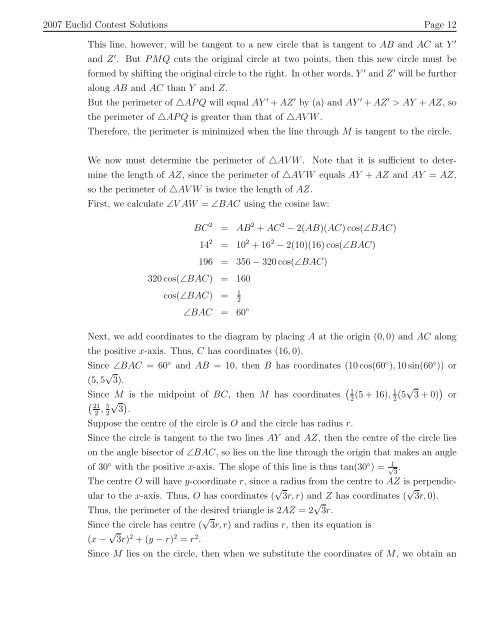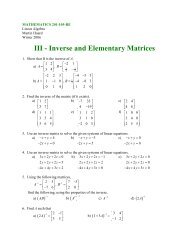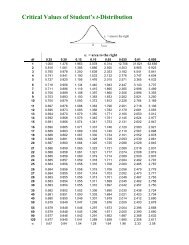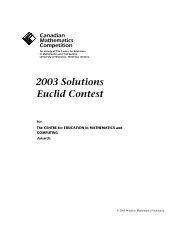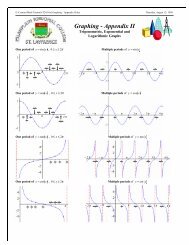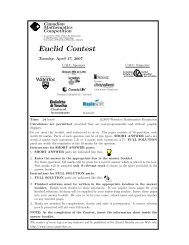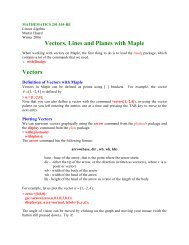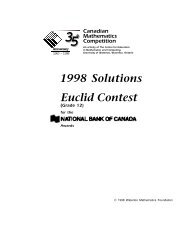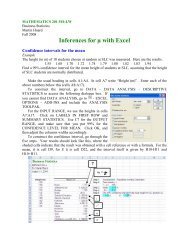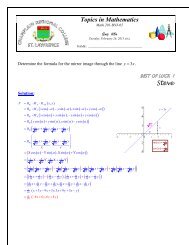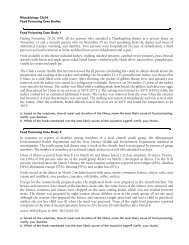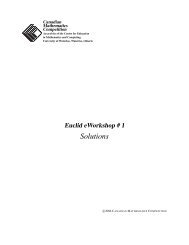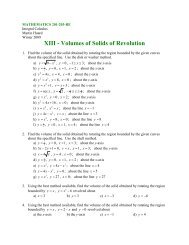Euclid Contest Solutions 2007 - CEMC - University of Waterloo
Euclid Contest Solutions 2007 - CEMC - University of Waterloo
Euclid Contest Solutions 2007 - CEMC - University of Waterloo
- No tags were found...
Create successful ePaper yourself
Turn your PDF publications into a flip-book with our unique Google optimized e-Paper software.
<strong>2007</strong> <strong>Euclid</strong> <strong>Contest</strong> <strong>Solutions</strong> Page 12This line, however, will be tangent to a new circle that is tangent to AB and AC at Y ′and Z ′ . But P MQ cuts the original circle at two points, then this new circle must beformed by shifting the original circle to the right. In other words, Y ′ and Z ′ will be furtheralong AB and AC than Y and Z.But the perimeter <strong>of</strong> △AP Q will equal AY ′ + AZ ′ by (a) and AY ′ + AZ ′ > AY + AZ, sothe perimeter <strong>of</strong> △AP Q is greater than that <strong>of</strong> △AV W .Therefore, the perimeter is minimized when the line through M is tangent to the circle.We now must determine the perimeter <strong>of</strong> △AV W .Note that it is sufficient to determinethe length <strong>of</strong> AZ, since the perimeter <strong>of</strong> △AV W equals AY + AZ and AY = AZ,so the perimeter <strong>of</strong> △AV W is twice the length <strong>of</strong> AZ.First, we calculate ∠V AW = ∠BAC using the cosine law:BC 2 = AB 2 + AC 2 − 2(AB)(AC) cos(∠BAC)14 2 = 10 2 + 16 2 − 2(10)(16) cos(∠BAC)196 = 356 − 320 cos(∠BAC)320 cos(∠BAC) = 160cos(∠BAC) = 1 2∠BAC = 60 ◦Next, we add coordinates to the diagram by placing A at the origin (0, 0) and AC alongthe positive x-axis. Thus, C has coordinates (16, 0).Since ∠BAC = 60 ◦ and AB = 10, then B has coordinates (10 cos(60 ◦ ), 10 sin(60 ◦ )) or(5, 5 √ 3).Since M is the midpoint <strong>of</strong> BC, then M has coordinates ( 1(5 + 16), 1(5√ 3 + 0) ) or2 2( 21 , √ ) 52 2 3 .Suppose the centre <strong>of</strong> the circle is O and the circle has radius r.Since the circle is tangent to the two lines AY and AZ, then the centre <strong>of</strong> the circle lieson the angle bisector <strong>of</strong> ∠BAC, so lies on the line through the origin that makes an angle<strong>of</strong> 30 ◦ with the positive x-axis. The slope <strong>of</strong> this line is thus tan(30 ◦ ) = 1 √3.The centre O will have y-coordinate r, since a radius from the centre to AZ is perpendicularto the x-axis. Thus, O has coordinates ( √ 3r, r) and Z has coordinates ( √ 3r, 0).Thus, the perimeter <strong>of</strong> the desired triangle is 2AZ = 2 √ 3r.Since the circle has centre ( √ 3r, r) and radius r, then its equation is(x − √ 3r) 2 + (y − r) 2 = r 2 .Since M lies on the circle, then when we substitute the coordinates <strong>of</strong> M, we obtain an


